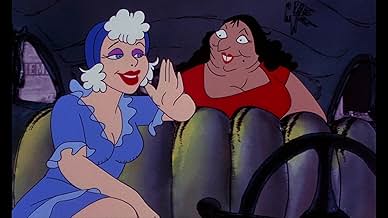Añade un argumento en tu idiomaAn underground cartoonist contends with life in the inner city, where various unsavory characters serve as inspiration for his art.An underground cartoonist contends with life in the inner city, where various unsavory characters serve as inspiration for his art.An underground cartoonist contends with life in the inner city, where various unsavory characters serve as inspiration for his art.
- Rosa
- (voz)
Argumento
¿Sabías que...?
- CuriosidadesHalf way into production as Bakshi was fired (before being re-hired). A different director stepped in and animated a train sequence in which Michael goes to visit his brother-in-law. He is on a subway and witness' a woman sleeping while two men begin to undress her. Michael just watches. As the woman wakes up, she screams "rape" toward Michael. This was in the original script, but was scrapped when Bakshi returned to the project, as he felt the scene was in bad-taste.
- Citas
[first lines]
Michael: What makes you happy? What makes you happy? Where do you go? Where do you go? Where do you hide? Where do you hide? Who do you see? Who do you see? Who do you trust? Who do you trust? Who do you screw? Who do you screw? What kills the pain? What kills the pain? Game up, game win. Bug around, set it straight. Transaction. Play it hard, hurts so bad. Gotta win. Everyone loses. Everything loses. Gotta win big. Sick and tired of losing. Where does it all go? Where does it all go? Where does it lead us? Where does it lead us? Tilt City, Pinball Alley. Blinkin' lights shot to Hell, fuck it all!
- Versiones alternativasIn 1974, the film was cut and rereleased with an "R" rating, replacing the previous "X" rated version.
- ConexionesEdited from La calle 42 (1933)
Doubtlessly a very personal movie. Sort of like 8 and a half if 8 and a half was made by a graffiti artist. A lurid and grotesque affair, itself like a piece of graffiti splattered on an inner city wall. It is deliberately unlovely in its caricature of urban life complete with racial stereotypes, italic mobsters and bizarre transsexuals.
There's not much plot beyond these episodes of life and that's the point. Gradually the film becomes more about two alienated individuals, a cool black prostitute and an unsullied Jewish Italian Cartoonist, transcending differences in ethnoreligious background to try and make something in this bleak world even if it means being as brutal as everyone else is. I feel the usage of stereotypic images of black people, gays, jews etc. Helps even a tolerant viewer break into the mindset of people at this place and time where the colour of your skin and whether you wore a cross, crucifix or a 6 pointed star meant everything about who you are.
There's a certain lyricism in the way the movie is handled; the way that one can try and find beauty of sorts even in the ugliest of back drops and that's what I like most about the movie; it's an artist genuinely putting a piece of themselves on the screen with less regard about how many people like it but who likes it. It's ambitious and stylized but strangely unpretentious about it since it does nothing in half measures where we meander from sordid realism to daliesque bizarrity with a kitsch twist.
The trailer was spot on: "it's funny, but it's not a comedy; it's animated but it's not a cartoon". That sums it up pretty well.
This didn't charm me the way some other of Bakshi's movies did but often a movie is an oblique view into the mind of the maker. Here we've had a chance to get more or less a full view.
- GiraffeDoor
- 3 jun 2019
- Enlace permanente
Selecciones populares
- How long is Heavy Traffic?Con tecnología de Alexa
Detalles
- Fecha de lanzamiento
- País de origen
- Sitio oficial
- Idiomas
- Títulos en diferentes países
- Heavy Traffic
- Localizaciones del rodaje
- Empresas productoras
- Ver más compañías en los créditos en IMDbPro
Taquilla
- Recaudación en Estados Unidos y Canadá
- 1.343.341 US$
Contribuir a esta página





























